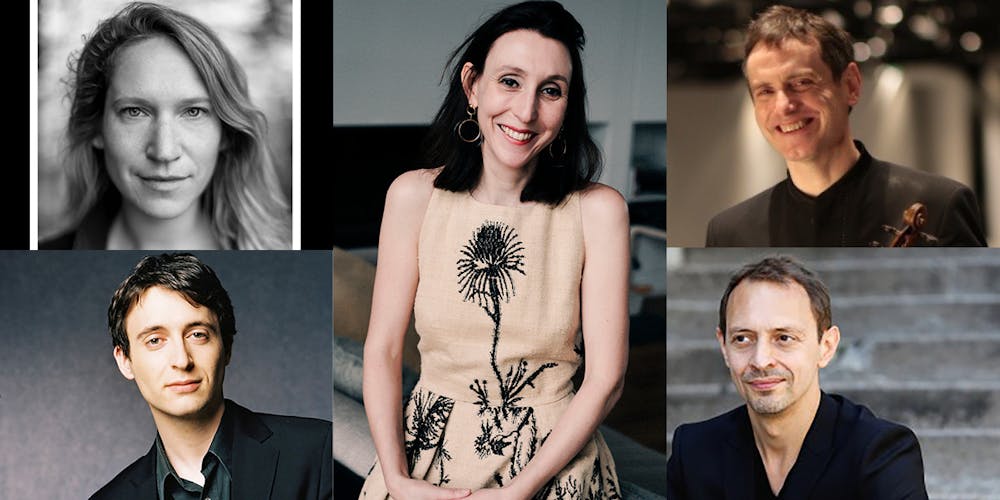Duke Arts recently hosted a performance of "Duras Song," an experience created by Duke professor Anne-Gaëlle Saliot combining classical music, original text, and the written works of French artist Marguerite Duras.
On Tuesday, Oct. 24, an audience gathered in the Nelson Music Room at 7:30 p.m. to enjoy the performances of violinist Gabriel Richard, cellist Xavier Philips, pianist Jean-Frédéric Neuburger and actress Amanda Gann. Professor Saliot is not only the creator of "Duras Song" but also contributed her own writings and provided mise-en-scène for the performance.
"Duras Song" naturally centers the life and work of Marguerite Duras, a tour-de-force artist who worked in a variety of mediums. Duras commanded a mastery of language in her novels, plays and essays while simultaneously honing her skills as a screenwriter and experimental filmmaker. Her art often dealt with contemporary social issues like the complex legacy of French colonialism.
Marguerite Duras became a legendary figure in both French literature and cinema, noted for the lyricism of her prose and the potent intricacy of her storytelling regardless of medium. Some of her most famous works include her fictionalized autobiography "L'Amant" and the screenplay for Alain Resnais' film "Hiroshima mon amour."
The first performance of "Duras Song" was in June of 2023 at the Philharmonie de Paris, entirely in French. Part of the work for the performance at Duke was translating large chunks of the original "Duras Song" for a majority English-speaking audience.
The English translation of "Duras Song" at Duke opened with an empty stage bathed in complete darkness. There was little light and even less sound as the performers slipped into their seats. Then, the room was instantly illuminated as musicians flicked on two pull chain lamps, the room's sole light source.
"Duras Song" was characterized by its nonlinear intertextual development within a minimal yet emotionally tense mise-en-scène. As Duras’ writings are both metaphorically and syntactically musical, it is admittedly difficult to blend two modes of sounds, words and notes, together in a shared space, yet the concert channels its listeners to touch every corner of Duras’ writing – its tension and exaltation, its ambivalence and elusiveness – until we, the audience, melt into her lines.
The concert starts with "India Song," a serene piano theme that recurs in Duras’ works, and as the opening of the concert that introduces the audience to Duras’ literary landscape. It contains forms in literature, music, and film, three essential domains of Duras’ body of work. While "India Song" looms with a lugubrious ambience, it sets a contemplative tone for the whole concert as Duras’ signature artistic work. Following are Bach’s prelude (excerpt from “The Cello Suite Nr in G major BWV 1007”) and Contrapuntos I (excerpt from “The Art of the Fugue BWV 1080”), both of which endow "Duras Song" with a timeless quality.
There are clear oscillations between scenes. "Duras Song" is structured within the flow of emotions: the first three pieces are light, solo performances of collected classical music, while as the concert advances, the audience traverses to different musical places with drastic changes of form and style. One turning point of the concert is when the potent string chords of Frédéric Chopin’s “Trio for Piano, Violin and Cello in G minor op.8” break in. An abrupt burst, Chopin’s trio disrupts the emotional continuity of previous pieces, yet all the entanglements in Duras’ words gradually unfold as the trio develops. Everything is in this one piece – scales that resemble roller coasters, changes of tempo, alternate melodies – nuanced, theatrical, eloquent.
Chopin’s “Waltz in A minor op. 34 Nr 2,” on the contrary, brings back the atmosphere of tacitness and somberness. This piece is performed with the Actress’ words from “Duras’ L'Amant.” Instead of rendering it a lamentful, nostalgic soliloquy, the words themselves seem expressive and almost conversive along with the soft confession of piano. While “Chaconne for Solo Violin” by Bach employs more complicated techniques, it presents with higher emotional intensity solely contained by violin, embodying and complicating the imaginations in the texts.
"Duras Song" closes with fictional and popular songs such as “Ramona,” “The Neva,” “Allô Maman Bobo” and Chopin’s Waltz op. 64 Nr 1: “Dog Waltz,” finishing with a playfully light-hearted tone. The concert ultimately ends with an apocalyptic line accompanied by fades-out of all lighting, engulfed by silence and darkness, the audience hold their breath for a few, full seconds as if they are about to enter another literary-musical space yet are finally taken back by a French popular song. Duras’ era does not end. The concert revitalizes the literary and musical power of her words and speaks to the audience of this remotely recent time of childhood and memories, of love and loss, of traces of violence and colonialism and everything upon her geo-musical legacy– everything that’s not been left behind today.
Get The Chronicle straight to your inbox
Signup for our weekly newsletter. Cancel at any time.

Bennett Gillespie is a Trinity first-year and a staff reporter for the news department.

